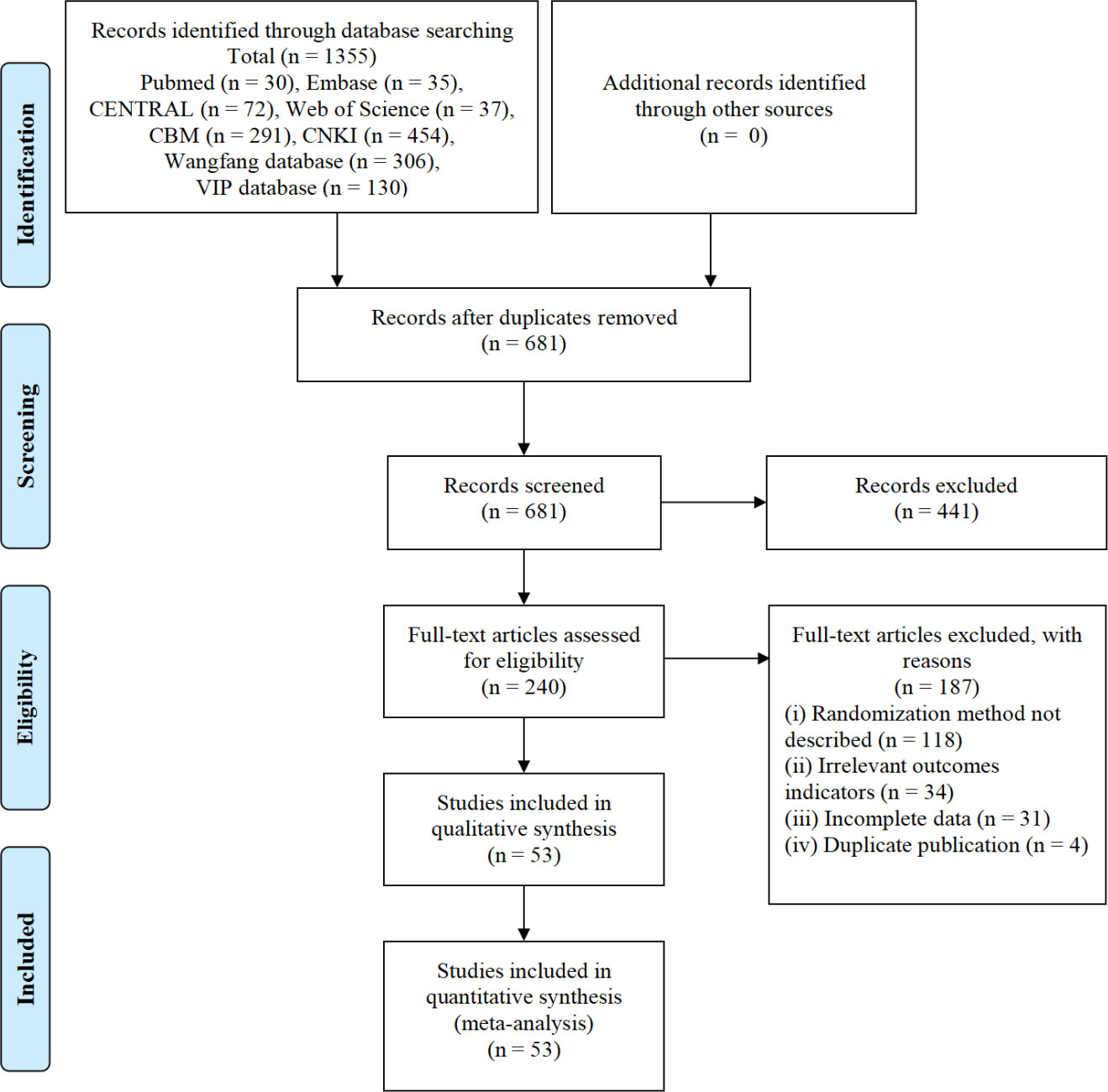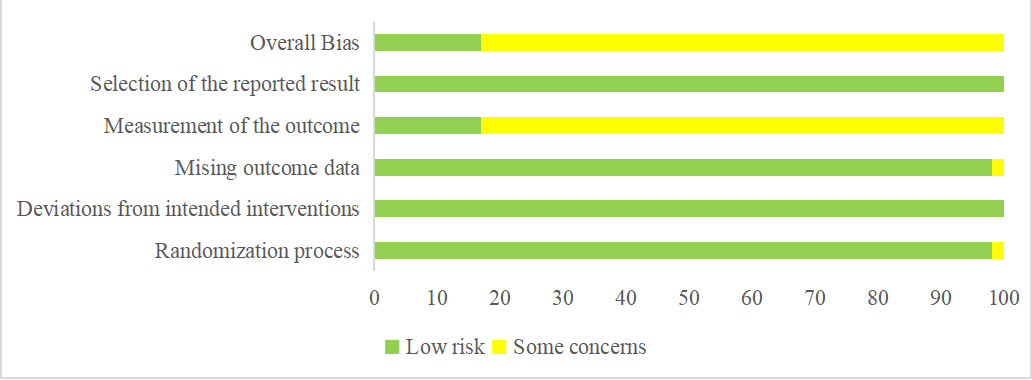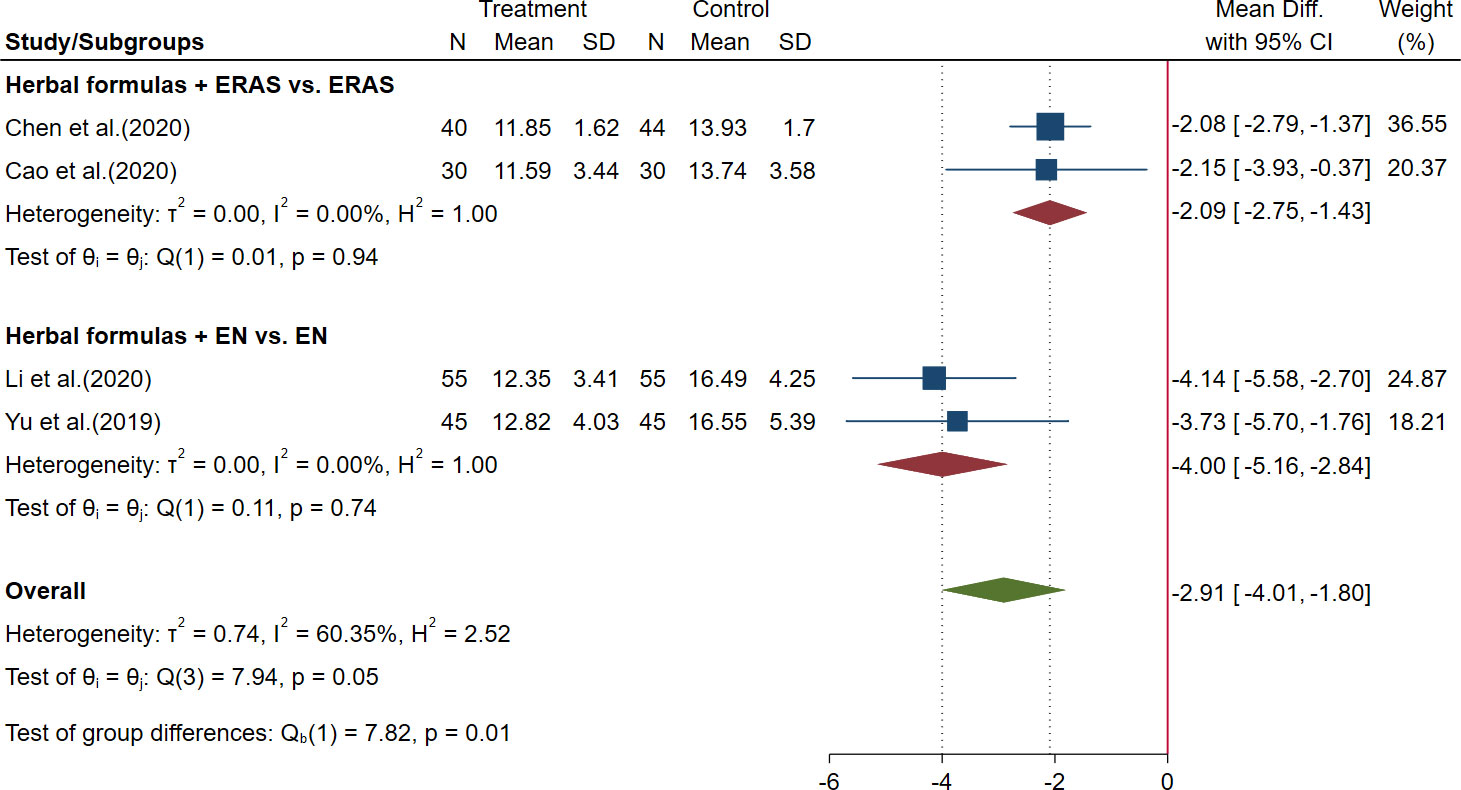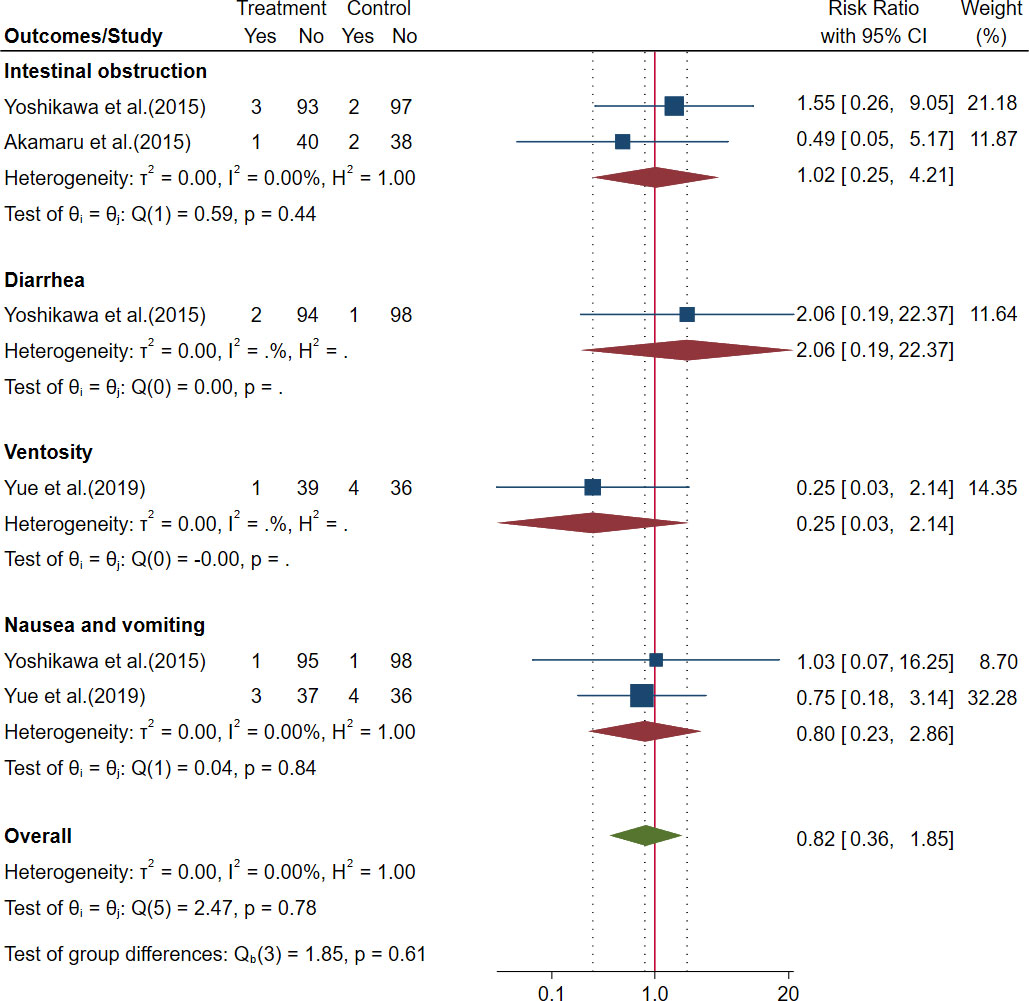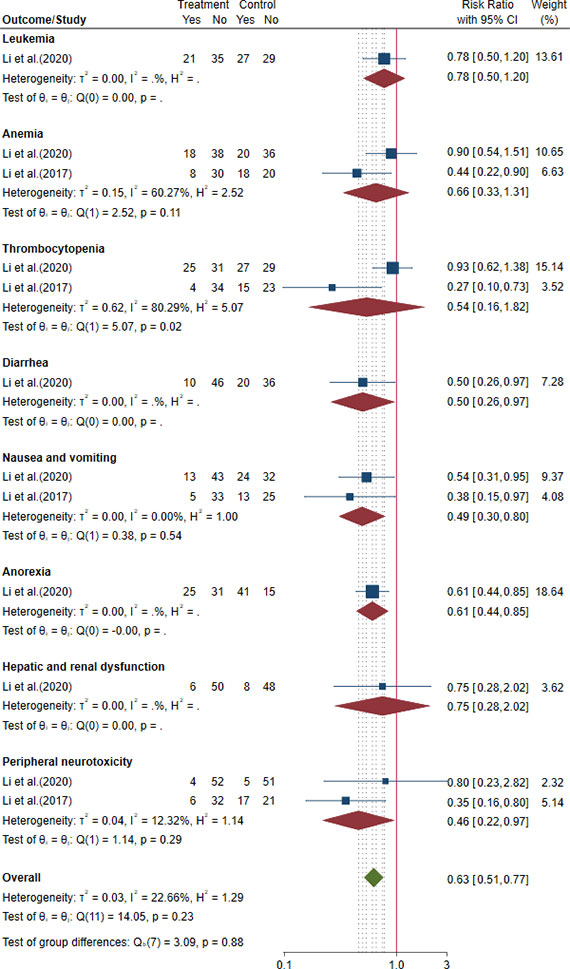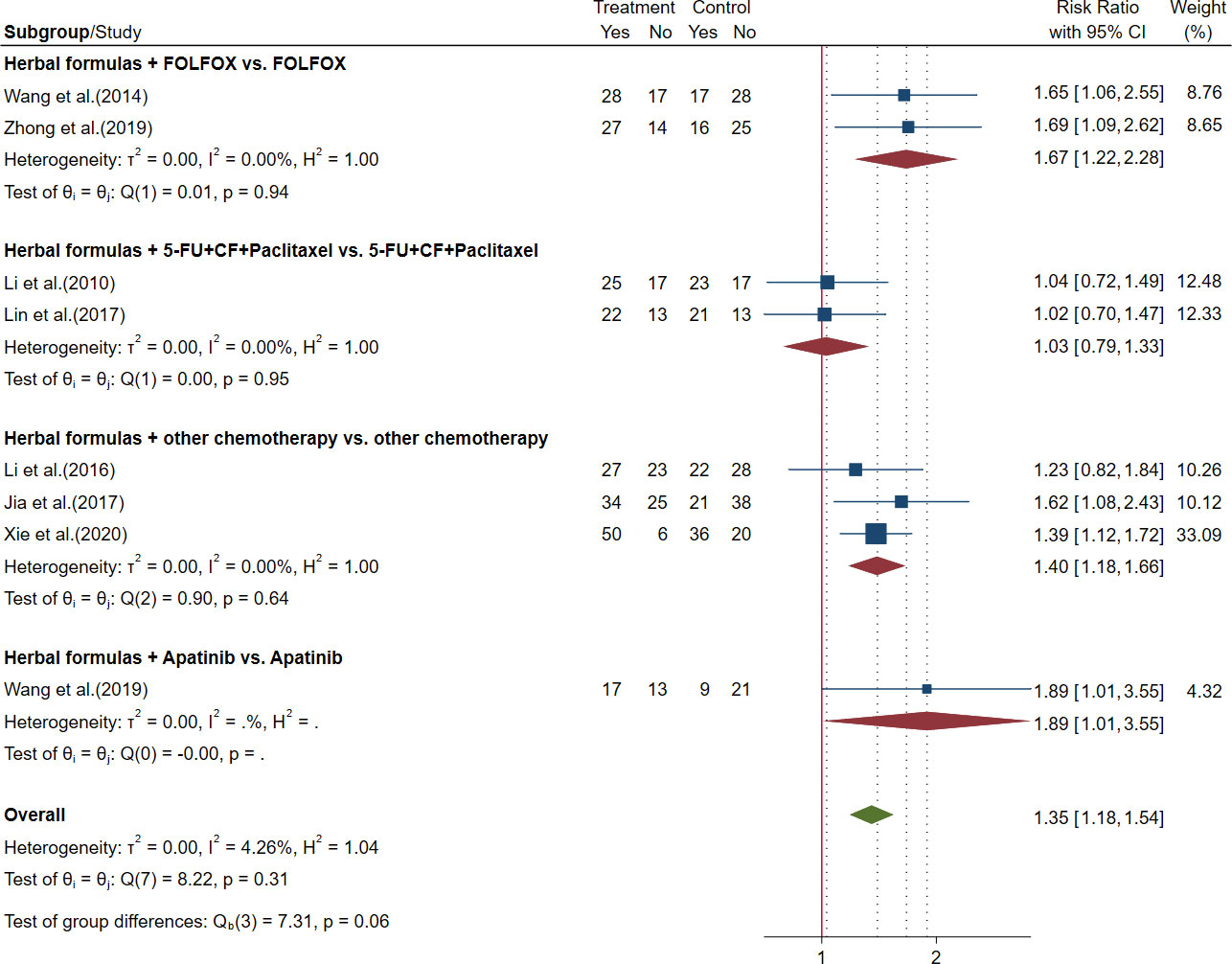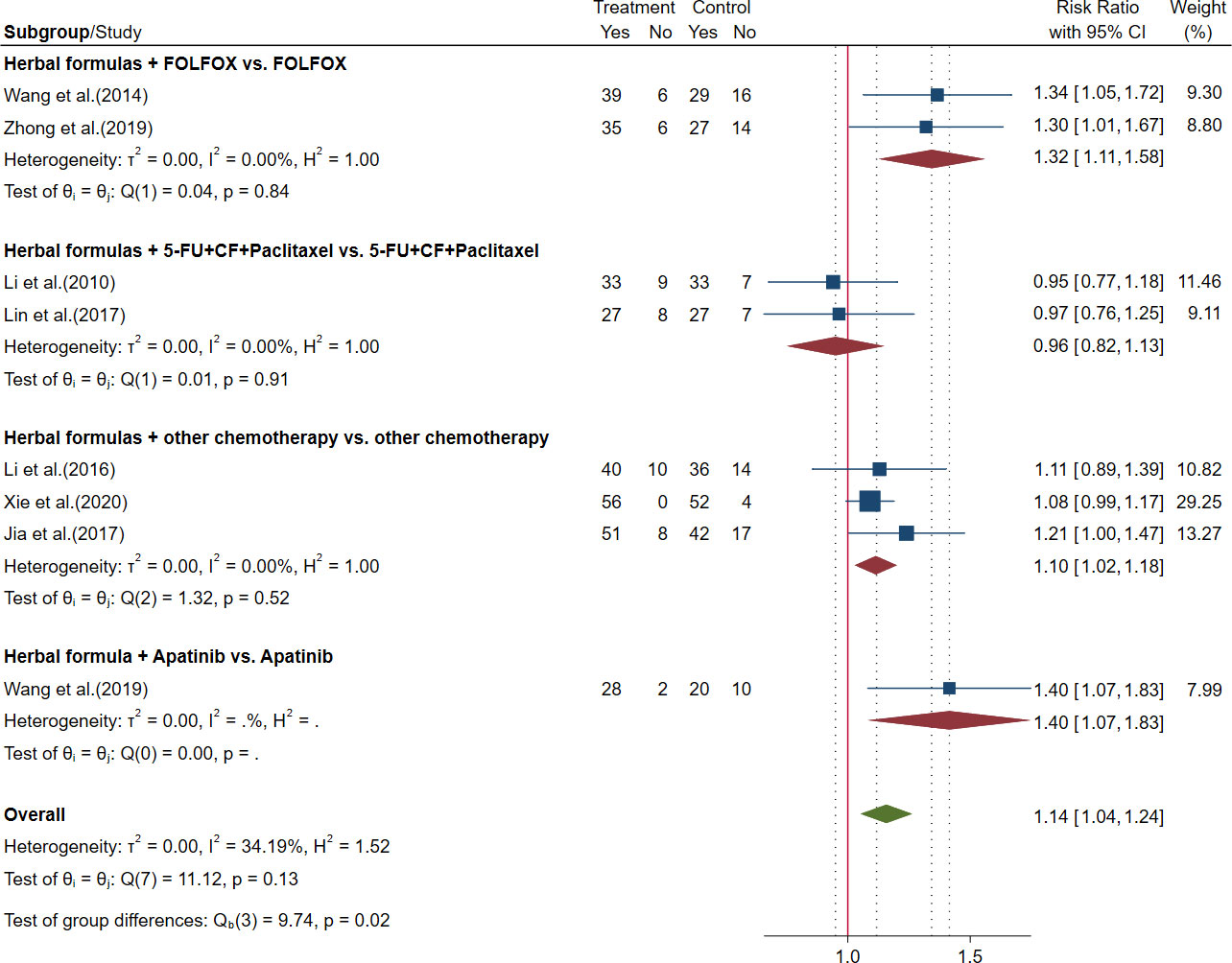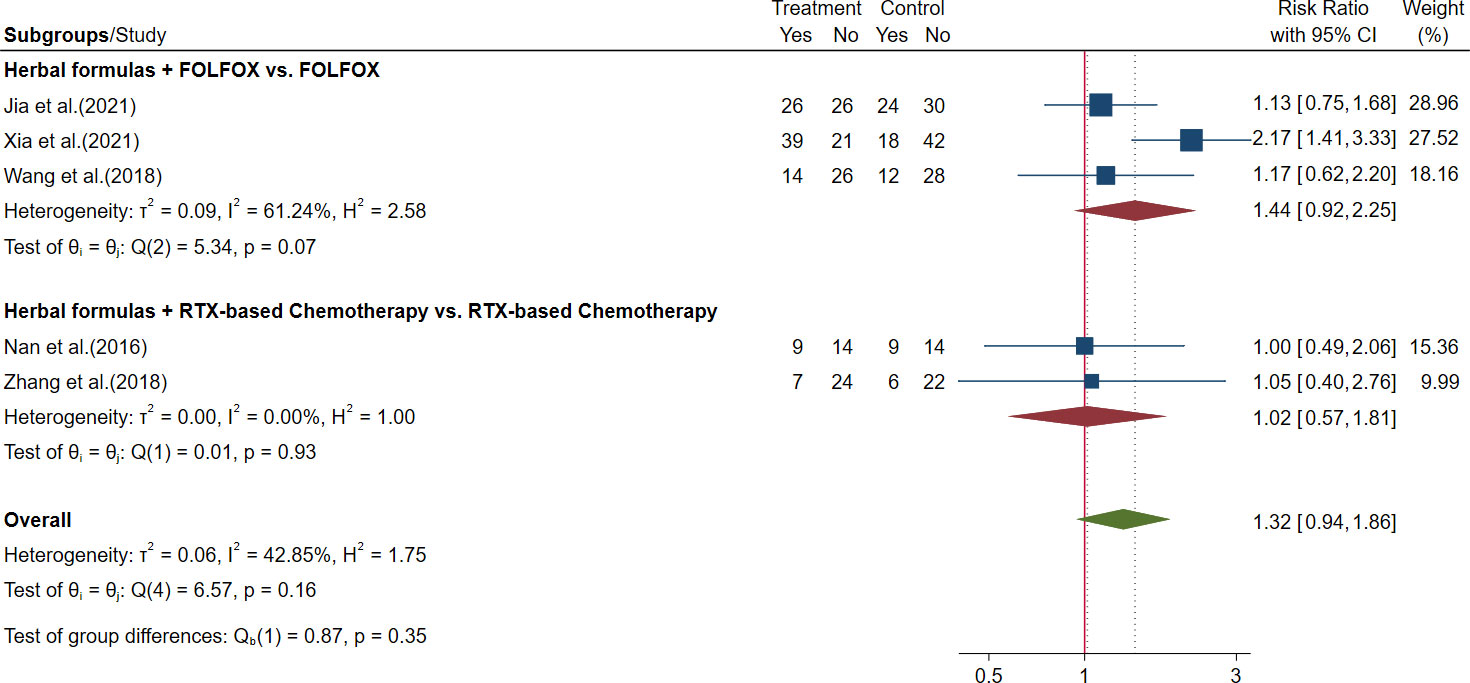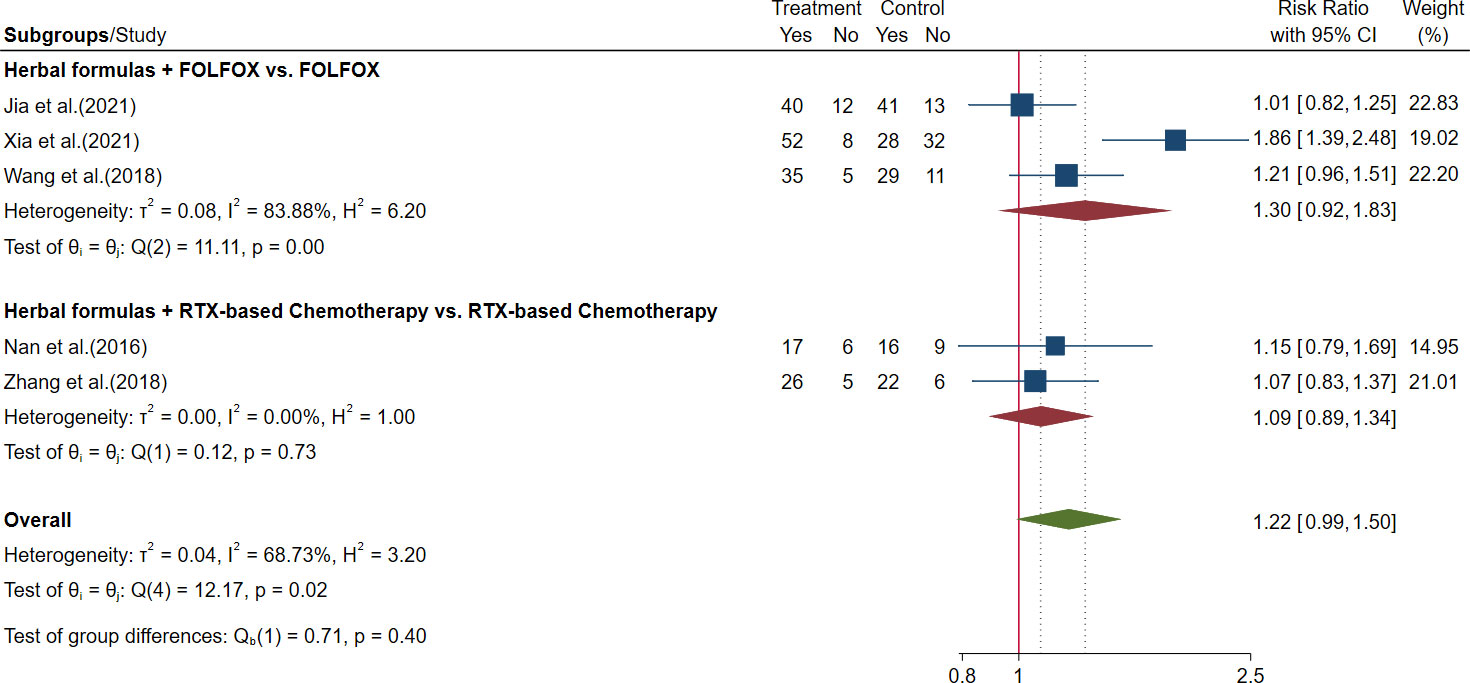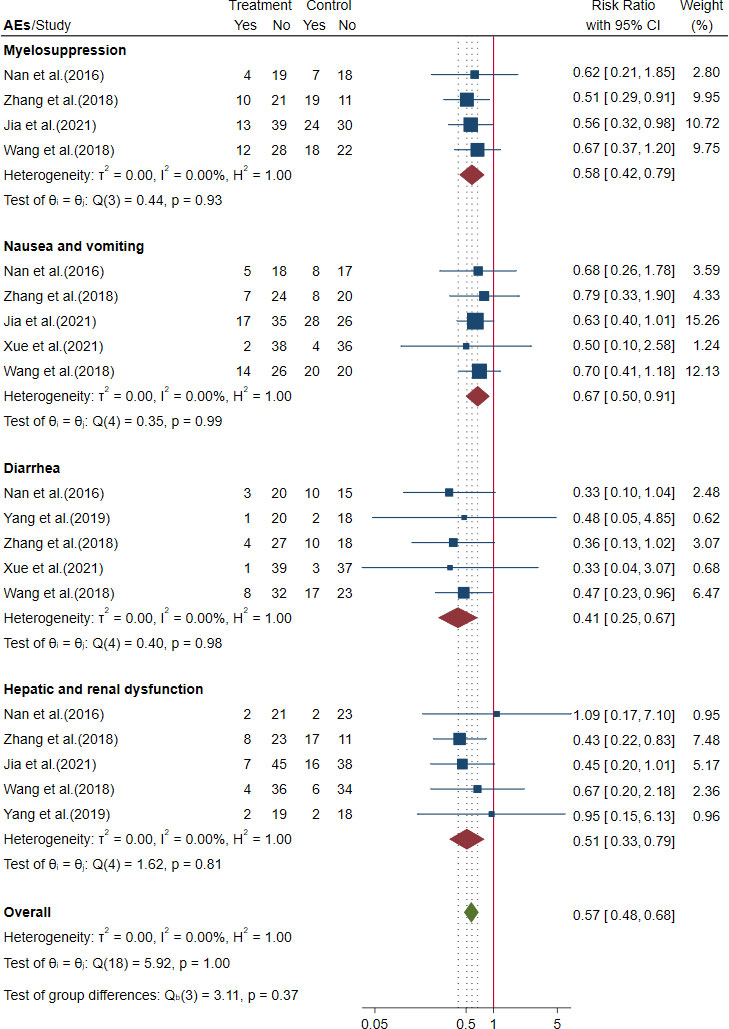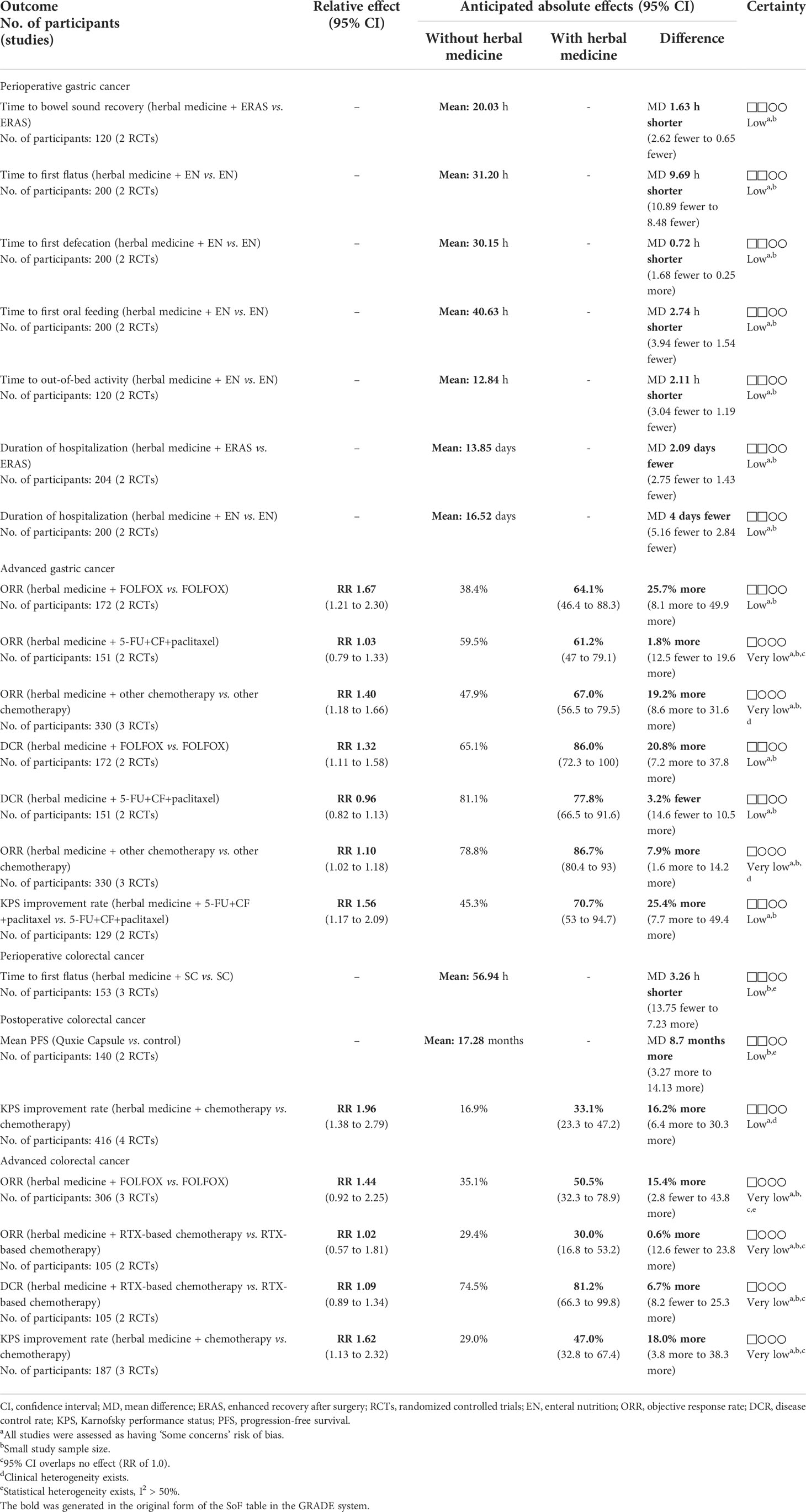Efficacy and safety of herbal formulas with the function of gut microbiota regulation for gastric and colorectal cancer: A systematic review and meta-analysis
- 1Department of Oncology, Guang’anmen Hospital, China Academy of Chinese Medical Sciences, Beijing, China
- 2Graduate School, Beijing University of Chinese Medicine, Beijing, China
- 3Department of Rheumatology, Guang’anmen Hospital, China Academy of Chinese Medical Sciences, Beijing, China
Background: Currently, gastric cancer (GC) and colorectal cancer (CRC) are the most common causes of cancer-related mortality worldwide. Gut microbiota is closely related to the occurrence of GC and CRC and the efficacy of chemotherapy. This study is aimed at evaluating the efficacy and safety of herbal formulas with the function of gut microbiota regulation (HFGMR) in the treatment of GC and CRC and to assess the quality of the synthesized evidence.
Methods: A comprehensive search was performed on eight electronic databases, PubMed, EMBASE, CENTRAL, Web of Science, Chinese Biomedical Literature Database, China National Knowledge Infrastructure, Wanfang database, Chinese Scientific Journals Database, and two registries, Chinese Clinical Trial Registry and ClinicalTrials.gov, from their initiation to January 2022. Randomized controlled trials (RCTs) studying the therapeutic effects of HFGMR were included. We used Stata 16 for data synthesis and Risk of Bias 2 (RoB 2) for methodological quality evaluation and assessed the quality of the synthesized evidence in the Grading of Recommendations, Assessment, Development and Evaluations (GRADE) approach.
Results: Fifty-three RCTs involving 4,478 patients were included. These trials involve seven herbal formulas that could regulate the gut microbiota of Bifidobacterium, Lactobacillus, Escherichia coli, Bacteroides, and Enterococcus faecalis. The meta-analysis results were subgrouped to three different stages in GC and CRC. 1) For the perioperative stage, HFGMR combined with conventional therapy could shorten the time to bowel sound recovery by 1.63 h [mean difference (MD) = −1.63, 95% confidence interval (CI) (−2.62, −0.65)], the time to first flatus by 9.69 h [MD = −9.69, 95% CI (−10.89, −8.48)], and the duration of hospitalization by 2.91 days [MD = −2.91, 95% CI (−4.01, −1.80)] in GC. There were no significant differences in outcomes of gastrointestinal function recovery and adverse events in CRC. 2) For postoperative patients, combined with adjuvant chemotherapy, HFGMR could decrease the incidence of diarrhea, nausea and vomiting, anorexia, and peripheral neurotoxicity in GC; boost Karnofsky performance status (KPS) improvement rate [risk ratio (RR) = 1.96, 95% CI (1.38, 2.79)]; and decrease the incidence of leucopenia and nausea and vomiting in CRC. 3) For advanced stage, HFGMR can significantly improve the objective response rate (ORR) [RR = 1.35, 95% CI (1.19~1.53)], disease control rate (DCR) [RR = 1.14, 95% CI (1.05~1.23)], and KPS improvement rate [RR = 1.56, 95% CI (1.17, 2.09)] and decrease the incidence of leucopenia, neutropenia, anemia, nausea and vomiting, diarrhea, and fatigue in GC. There were no significant differences in ORR [RR = 1.32, 95% CI (0.94~1.86)] and DCR [RR = 1.22, 95% CI (0.99~1.50)], but they can improve the KPS response rate [RR = 1.62, 95% CI (1.13, 2.32)] and decrease the incidence of myelosuppression, nausea and vomiting, diarrhea, and hepatic and renal dysfunction in CRC.
Conclusion: This study indicates that herbal formulas that could regulate the composition and proportion of gut microbiota have a positive effect in three stages (perioperative, postoperative, and advanced) of GC and CRC. They could promote the recovery of postoperative gastrointestinal function, increase tumor response, improve performance status, and reduce the incidence of adverse events. Herbal formulas exerted anti-cancer efficacy through multiple mechanisms and pathways; among them, the regulation of gut microbiota has not been paid enough attention. To further support the conclusion and better understand the role of gut microbiota in the treatment of GC and CRC, more rigorously designed, large-scale, and multicenter RCTs that focus on herbal formulas and gut microbiota are needed in the future.
1 Introduction
Gastric cancer (GC) and colorectal cancer (CRC), as the main gastrointestinal cancers, are common malignant cancers with high morbidity and mortality. According to the latest global cancer data published by JAMA Oncology (Kocarnik et al., 2021), the number of newly diagnosed CRC and GC patients in 2019 was 2,170,000 and 1,270,000, respectively, which leaves an unsolved health problem that affects people all over the world. Notably, studies have reported that gastrointestinal cancers are closely related to gut microbiota (Weng et al., 2019; Zhou et al., 2021), a large microbial community known as the ‘second gene’ existing in the intestinal tract that has a significant effect. Dysbiosis of gut microbiota can result in the production of carcinogenic bacteria (Fan et al., 2021), such as Bacteroides fragilis, Enterococcus faecalis, and Helicobacter hepaticus (Meng et al., 2018). These carcinogenic bacteria can secrete toxins, cause intestinal cell damage, and induce gastrointestinal cancers (Mármol et al., 2017; Cheng et al., 2020; Overacre-Delgoffe et al., 2021). On the contrary, the healthy gut microbiota can inhibit the growth of conditioned pathogenic bacteria and form a protective barrier to regulate gastrointestinal inflammation and immunity (Amoroso et al., 2020). Interestingly, it was reported that the transplantation of healthy fecal microbiota can prevent intestinal injury in CRC (Chang et al., 2020). Therefore, it is important to make a special effort to keep a healthy state of gut microbiota in the treatment of gastrointestinal cancers.
Traditional Chinese herbal medicine has a long history of treating diseases by regulating gut microbiota. As early as 1,400 years ago, ‘purified feces’ was mentioned in the book, ‘Lei’s Treatise on Preparing Drugs’. The ‘purified feces’ was produced by repeatedly washing the feces of healthy people with well or underground spring water and then filtering and burying them underground for at least 1 year. It is the earliest record of traditional Chinese herbal treatment for fecal microbiota transplantation. With the development of modern technology, studies have verified that herbal formulas have a good effect on the regulation of gut microbiota. For example, Gegenqinlian decoction can regulate intestinal mucosal immunity and glucolipid metabolism by enriching butyric-producing bacteria, thus reducing systemic and local pancreatic inflammation and improving insulin resistance (Xu et al., 2020). Ginseng extract can enrich E. faecalis and promote the production of unsaturated long-chain fatty acid-nutmeg oleic acid, which can stimulate the thermogenic activity of brown fat, induce the formation of beige fat, reduce fat accumulation, and improve obesity (Quan et al., 2020). Apart from metabolic diseases, Gegenqinlian decoction can enhance the effect of PD-1 blockade in CRC with microsatellite stability by remodeling the gut microbiota and the tumor microenvironment (Lv et al., 2019), indicating that herbal formulas can also treat gastrointestinal cancers by regulating the gut microbiota. With the growing number of studies on the value of herbal formulas in gastrointestinal cancer treatment, more randomized controlled trials (RCTs) have been published in recent years. This study is aimed to seek effective strategies for the treatment of gastrointestinal cancers through a systematic review and meta-analysis of herbal formulas with the function of gut microbiota regulation (HFGMR).
2 Methods
This study was performed under the guidance of the Preferred Reporting Items for Systematic Reviews and Meta-Analyses (PRISMA) statement and checklist (Moher et al., 2009); see PRISMA checklist in Supplementary Material 1. This study was registered on PROSPERO (No. CRD42021292096).
2.1 Eligibility criteria
2.1.1 Type of studies
This study included RCTs and observational studies, and quasi-RCTs were excluded. Trials that did not describe the randomization method in detail were considered non-randomized studies of interventions and were excluded. Animal studies were also excluded.
2.1.2 Types of participants
RCTs in which participants were diagnosed with GC or CRC through cytological or pathological tests were included.
2.1.3 Types of intervention and control
Randomized studies of herbal formulas with the function of gut microbiota regulation as the sole treatment or combined with other treatments were included in this study.
2.1.4 Types of outcomes
RCTs reporting outcomes related to clinical efficacy and safety of herbal formulas in gastrointestinal cancer treatment were included in this study. Trials that only reported outcomes of laboratory test results were excluded.
For perioperative patients, the outcomes of gastrointestinal function recovery, duration of hospitalization, time to first oral feeding, and time to out-of-bed activity were included; for postoperative or advanced patients, the outcomes of long-term survival and tumor response rate (TRR) of anti-cancer treatment were included; quality of life (QoL), performance status (PS), and incidence of adverse events (AEs) as safety outcomes were included for patients of all stages.
2.2 Selection of herbal formulas with the function of gut microbiota regulation
We performed a preliminary search to select the herbal formulas with the function of gut microbiota regulation. In order to locate appropriate herbal formulas that could regulate gut microbiota in patients with GC or CRC, we searched eight electronic databases with a search strategy based on the keywords ‘herbal medicine’, ‘Chinese medicine’, ‘Kampo medicine’, ‘gut microbiota’, ‘gastric cancer’, and ‘colorectal cancer’. We obtained 1,431 records from database searches, and nine formulas were located after our rigorous selection. These nine formulas were included as search terms in the further search for RCTs.
2.3 Search strategy
We searched PubMed, EMBASE, CENTRAL, Web of Science, the Chinese Biomedical Literature Database (CBM), the China National Knowledge Infrastructure (CNKI), the Wanfang database, and the Chinese Scientific Journals Database (VIP database). Searches were performed from the database initiation to January 2022. The language restriction was English and Chinese. We also searched the Chinese Clinical Trial Registry (ChiCTR) and ClinicalTrials.gov to identify ongoing and completed trials. The search strategy was based on the combination of controlled vocabulary (MeSH terms and Emtree terms) and free-text terms. The terms ‘Stomach Neoplasms’, ‘Colorectal Neoplasms’, ‘Colonic Neoplasms’, ‘Rectal Neoplasms’, ‘si-jun-zi-tang’, ‘gegenqinlian’, ‘liu-jun-zi-tang’, ‘xiaochaihu’, ‘shosaiko-to’, ‘danggui buxue decoction’, ‘shenling baizhu san’, ‘dai-kenchu-to’, ‘jishengwumeiwan’, and ‘quxie capsule’ were used to develop the search strategy for PubMed, which is shown in Supplementary Material 2. Modifications to the search strategy were used with other databases.
2.4 Screening and selection
Search results were imported to EndNote 20. Two authors (HW and BX) reviewed the titles and abstracts in the database search results after duplicate removal. The full texts of potential articles were then reviewed and assessed for their eligibility. Screening and selection were independently processed in duplicate by the two reviewers (HW and BX). RCTs that met the inclusion criteria were included. The process is summarized using a PRISMA flow diagram.
2.5 Data extraction
The following data were extracted from the included studies: 1) identification information (first author and year of publication), 2) general information (study setting, sample size, and duration of follow-up), 3) participants (clinical stage, age, and sex), 4) intervention details (name of herbal formulas, dose, frequency, and duration), 5) comparison details (name, dose, frequency, and duration of treatment), and 6) outcome details. The authors of the trials were contacted for any missing or incomplete data.
2.6 Quality assessment
The Risk of Bias 2 (RoB 2) tool was used to assess the methodological quality of included studies (Sterne et al., 2019). We evaluated outcomes of included studies of the risk of bias of the randomization process, deviation from intended intervention, missing outcome data, outcome measurement, and selection of the reported result; the overall quality of RCTs was evaluated as low, with some concerns or high risk of bias.
2.7 Evidence synthesis for randomized controlled trials
Stata 16 was used in data synthesis to perform a meta-analysis. The mean differences (MDs) for continuous data and risk ratio (RR) for dichotomous data with 95% confidence intervals (CIs) were evaluated. The random-effects model was used when synthesizing data for the meta-analysis. We quantified inconsistency by applying the I2 statistic; a value of I2 > 50% was considered substantial heterogeneity, and I2 > 75% was considered heterogeneity (Higgins et al., 2019). Subgroup analyses were performed according to the different treatments that patients received in control groups and to explore the source of heterogeneity if substantial heterogeneity existed. A meta-analysis was precluded in some conditions (limited evidence for comparison, existence of considerable heterogeneity, or different effect measures) (Higgins et al., 2019), and descriptive analysis was used in these conditions.
Given the strong correlation between the two anti-tumor treatment response evaluation criteria, WHO criteria, and Response Evaluation Criteria in Solid Tumors (RECIST) criteria, the outcomes reported by these two criteria were considered homogeneous (Aras et al., 2016).
Publication bias of the cumulative evidence among individual studies was evaluated using a graphical method of funnel plot and Egger’s test (Egger et al., 1997) if at least 10 studies were included for the synthesized outcome.
2.8 Quality of evidence
The quality of the cumulative evidence was evaluated using the Grading of Recommendations, Assessment, Development, and Evaluations (GRADE) system (Guyatt et al., 2008). The risk of bias, inconsistency, indirectness, imprecision, and publication bias were evaluated. The quality of evidence was classified as high, moderate, low, or very low quality (Guyatt et al., 2008). We presented our findings in a summary of findings (SoF) table.
3 Results
We obtained 1,355 records from database searches, and after the selection process, there were 53 trials involving 4,478 participants included in this SR. The selection process was summarized as a flowchart shown in Figure 1.
3.1 Details of included trials
Among these 53 trials, there are five double-blinded RCTs, and four of them were conducted in multicenter. The sample size of included trials ranged from 17 to 336. Most of the included trials were RCTs of a small sample size conducted in a single center. The details are shown in Table 1.
3.1.1 Intervention details
The intervention of treatment included seven formulas that had been verified with the function of regulating gut microbiota in clinical studies. These seven herbal formulas could regulate the composition and proportion of gut microbiota. Bacteroides, Bifidobacterium, Lactobacillus, E. faecalis, and Escherichia coli were the most reported gut microbiota regulated by these herbal formulas. The function of gut microbiota regulation in these seven formulas is shown in Table 2. A total of 14 trials evaluated the efficacy and safety of Liujunzi decoction and modified Liujunzi decoction in GC and CRC, 13 trials evaluated the efficacy and safety of Shenlingbaizhu powder and modified formulas of Shenlingbaizhu in GC and CRC, 12 trials evaluated the efficacy and safety of Sijunzi decoction and modified Sijunzi decoction in GC and CRC, 7 trials evaluated the efficacy and safety of Kampo herbal medicine Daikenchuto (known as Dajianzhong decoction in Chinese medicine) in perioperative patients with GC or CRC, 4 trials evaluated the efficacy and safety of Quxie Capsule in patients with CRC, 2 trials evaluated the efficacy and safety of Danggui Buxue decoction in CRC, and 1 trial evaluated the efficacy and safety of Gegen Qinlian decoction in postoperative CRC patients who underwent adjuvant chemotherapy. The gut microbiota regulating the function of these eight formulas is shown in Table 2.
3.1.2 Risk of bias in included trials
We assessed the risk of bias in 53 included trials with the RoB 2 tool. A total of 9 trials were assessed as ‘Low’ risk of bias, and 44 trials were assessed as having ‘Some concerns’. Most concerns were caused by the measurement of the outcomes since the assessment of outcomes could be influenced by knowledge of interventions that patients received. Among nine low risk-of-bias trials, five were double-blinded RCTs, two trials implemented a blind method to outcome assessors, and another two trials reported survival outcomes that may not be influenced by knowledge of interventions. The summary of the risk of bias is shown in Figure 2.
3.2 Herbal formulas with the function of gut microbiota regulation for gastric cancer
3.2.1 Herbal formulas with the function of gut microbiota regulation for perioperative gastric cancer
There are nine trials that evaluated the efficacy and safety of HFGMR in perioperative patients with GC. The outcomes of gastrointestinal function recovery, which include time to bowel sound recovery, time to first flatus, and time to the first defecation, were reported in eight trials. Furthermore, five trials reported the outcome of the duration of hospitalization, and two trials reported time to first oral feeding and time to the out-of-bed activity.
3.2.1.1 Gastrointestinal function recovery in perioperative gastric cancer
Three trials reported time to bowel sound recovery, and a meta-analysis of two trials showed that the herbal formulas plus enhanced recovery after surgery (ERAS) could shorten the time to bowel sound recovery by 1.63 h [MD = −1.63, 95% CI (−2.62, −0.65)] (Huang et al., 2018; Cao et al., 2020), and one trial reported that herbal formulas plus supportive care (SC) could significantly shorten the time to bowel sound recovery (Yue et al., 2019); the results are shown in Table 3. Eight trials reported the outcome of time to first flatus, and a meta-analysis of two trials showed that the herbal formulas plus enteral nutrition (EN) could shorten the time to first flatus by 9.69 h [MD = −9.69, 95% CI (−10.89, −8.48)] (Li et al., 2020; Yu and Ren, 2019; Li et al., 2020), three trials reported that the herbal formulas plus ERAS could significantly shorten time to first flatus (Huang et al., 2018; Chen et al., 2020; Cao et al., 2020), two trials reported that the herbal formulas plus SC could significantly shorten time to first flatus (Fu et al., 2007; Yue et al., 2019), and another trial reported that no significant difference was observed between the herbal formulas plus SC and SC groups (Yoshikawa et al., 2015), but a meta-analysis was not conducted due to the existence of considerable heterogeneity within these two subgroups; the results are shown in Table 3. Six trials reported the outcome of time to the first defecation, one trial reported that herbal formulas plus ERAS could shorten the time to first defecation (Chen et al., 2020), and a meta-analysis of two trials showed that there was no significant difference in time to the first defecation between patients who received herbal formulas plus EN and the EN group [MD = −0.72, 95% CI (−1.68, 0.25)] (Li et al., 2020; Yu and Ren, 2019), two trials reported that the herbal formulas plus SC could significantly shorten time to first defecation (Yoshikawa et al., 2015; Yue et al., 2019), and another trial reported that no significant difference was observed between the herbal formulas plus SC and SC groups (Akamaru et al., 2015). A meta-analysis was not conducted due to the existence of considerable heterogeneity within the subgroup; the results are shown in Table 3.

Table 3 Results of efficacy and safety of herbal formulas with function of gut microbiota regulation in GC and CRC.
3.2.1.2 Other outcomes in perioperative gastric cancer
Five trials reported the duration of hospitalization: four of these trials reported that HFGMR could shorten the duration of hospitalization, while one trial reported there was no significant difference between the two groups in postoperative hospital stay and did not provide the data in detail (Yoshikawa et al., 2015). The meta-analysis showed that the herbal medicine plus ERAS could shorten the duration of hospitalization by 2.09 days [MD = −2.09, 95% CI (−2.75, −1.43)] (Chen et al., 2020; Cao et al., 2020) and could shorten the duration of hospitalization by 4.00 days when combined with EN [MD = −4.00, 95% CI (−5.16, −2.84)] (Li, 2020; Yu and Ren, 2019). The results are shown in Figure 3 and Table 3.
The meta-analysis of two trials showed that herbal medicine plus EN could shorten the time to first oral feeding by 2.74 h [MD = −2.74, 95% CI (−3.94, −1.54)] and shorten the time to out-of-bed activity by 2.11 h [MD = −2.11, 95% CI (−3.04, −1.19)] (Li, 2020; Yu and Ren, 2019). The results are shown in Table 3. Two trials reported that there was no significant difference in QOL scores between the treatment groups of herbal medicine and the control groups (Yoshikawa et al., 2015; Akamaru et al., 2015). One trial reported that herbal formula could help improve the Karnofsky performance status (KPS) score significantly (Cao et al., 2020); the result is shown in Table 3.
3.2.1.3 Safety outcomes in perioperative gastric cancer
There were no significant differences in the incidence of intestinal obstruction, diarrhea, ventosity, nausea, and vomiting; the results are shown in Figure 4 and Table 3.
3.2.2 Herbal formulas with the function of gut microbiota regulation plus adjuvant chemotherapy for postoperative gastric cancer
Two trials evaluated the clinical efficacy and safety of HFGMR plus FOLFOX4 adjuvant chemotherapy compared to FOLFOX4 chemotherapy alone for postoperative patients with GC (Li, 2017; Li et al., 2020a).
3.2.2.1 Efficacy outcomes in postoperative gastric cancer
One trial reported long-term survival outcomes of herbal formulas plus FOLFOX4 chemotherapy, and there was no significant difference in the 2-year survival rate between herbal formulas plus chemotherapy and chemotherapy alone (94.74% vs. 92.11%) (Li, 2017). One trial reported a QoL score, and the result demonstrated that herbal formulas plus chemotherapy could improve the QoL score by 0.94 points [MD = 0.94, 95% CI (0.70, 1.18)] (Li et al., 2020a). Another trial showed that herbal formula plus chemotherapy could improve the KPS score by 9.29 points [MD = 0.94, 95% CI (7.55, 11.03)], compared to FOLFOX4 chemotherapy alone (Li, 2017).
3.2.2.2 Safety outcomes in postoperative GC
Both two trials reported AEs (Li, 2017; Li et al., 2020a). The results showed that compared to FOLFOX chemotherapy alone, HFGMR plus FOLFOX chemotherapy may decrease the incidence of diarrhea, nausea and vomiting, anorexia, and peripheral neurotoxicity, and there were no significant differences in the incidence of leucopenia, anemia, thrombocytopenia, and hepatic and renal dysfunction. The results are shown in Figure 5 and Table 3.
3.2.3 Herbal formulas with the function of gut microbiota regulation for advanced gastric cancer
Twelve trials evaluated the efficacy and safety of HFGMR in patients with advanced GC. Eleven trials compared herbal formulas plus chemotherapy with chemotherapy alone, and another trial compared herbal formulas plus apatinib with apatinib alone (Wang et al., 2019).
3.2.3.1 Long-term survival outcomes in advanced gastric cancer
One trial reported the long-term survival outcomes of median progression-free survival (mPFS) and median overall survival (mOS); the results showed that compared to ECF (Epirubicin + Cisplatin + Fluorouracil) regimen chemotherapy alone, herbal formula plus ECF regimen chemotherapy could significantly prolong the mPFS (5.86 ± 0.26 vs. 5.52 ± 0.33 months) and mOS (13.08 ± 0.25 vs. 12.84 ± 0.19 months) (Shen et al., 2021).
3.2.3.2 Outcomes of tumor response rate in advanced gastric cancer
Eight trials reported the outcomes of ORR and disease control rate (DCR). The meta-analysis showed that HFGMR plus FOLFOX regimen chemotherapy and other regimen chemotherapy could significantly increase the ORR and DCR, but no significant differences were observed in ORR and DCR between herbal formulas plus 5-FU+CF+paclitaxel chemotherapy and 5-FU+CF+paclitaxel regimen alone. The results are shown in Figures 6, 7 and Table 3.
3.2.3.3 Other efficacy outcomes in advanced gastric cancer
One trial demonstrated that compared to TXELOX (Taxol + Xeloda + Oxaliplatin) regimen chemotherapy alone, herbal formulas plus TXELOX may improve QoL score by 3.62 points [MD = 3.62, 95% CI (3.31, 3.93)] (Wang and Yan, 2020). Five trials reported that herbal formulas could help to improve the KPS score, but the meta-analysis was not conducted owing to the existence of considerable heterogeneity (Zhang and Su, 2008; Wang et al., 2014; Zhong et al., 2019; Wang and Yan, 2020; Wang et al., 2019). As for KPS improvement rate, a meta-analysis of two trials showed that compared to 5-FU+CF+paclitaxel regimen chemotherapy alone, herbal formulas plus 5-FU+CF+paclitaxel could increase the improvement rate by 56% [RR = 1.56, 95% CI (1.17, 2.09)] (Lin et al., 2017; Lai et al., 2018), and another trial showed that the KPS improvement rate may not differ between herbal formulas plus TS regimen chemotherapy and TS regimen alone (Li et al., 2016).
3.2.3.4 Safety outcomes in advanced gastric cancer
Eleven trials reported the incidence of AEs in advanced GC. The meta-analysis showed that compared to chemotherapy alone, herbal formulas plus chemotherapy could decrease the incidence of leucopenia by 17% [RR = 0.83, 95% CI (0.70, 0.98)], neutropenia by 27% [RR = 0.73, 95% CI (0.56, 0.95)], anemia by 46% [RR = 0.56, 95% CI (0.35, 0.89)], nausea and vomiting by 38% [RR = 0.62, 95% CI (0.45, 0.85)], diarrhea by 30% [RR = 0.70, 95% CI (0.53, 0.91)], and fatigue by 51% [RR = 0.49, 95% CI (0.31, 0.77)], and there were no significant differences in the incidence of thrombocytopenia, anorexia, and hepatic dysfunction; the details of the results are shown in Table 3.
3.3 Herbal formulas with the function of gut microbiota regulation for colorectal cancer
3.3.1 Herbal formulas with the function of gut microbiota regulation for perioperative colorectal cancer
There are eight trials that evaluated the efficacy and safety of HFGMR in perioperative patients with CRC (Chen, 2013; Yaegashi et al., 2014; Katsuno et al., 2015; Katsuno et al., 2016; Hanada et al., 2021; Yang et al., 2021; Wakasugi et al., 2020; Zhang, 2020). The outcomes of gastrointestinal function recovery, which include time to bowel sound recovery, time to first flatus, and time to the first defecation were reported in six trials (Chen, 2013; Yaegashi et al., 2014; Katsuno et al., 2016; Zhang, 2020; Wakasugi et al., 2020; Yang et al., 2021). Moreover, duration of hospitalization, time to first oral feeding, time to an out-of-bed activity, and safety outcomes were also reported in these trials.
3.3.1.1 Gastrointestinal function recovery in perioperative colorectal cancer
One trial reported that compared to EN alone, herbal formula plus EN may shorten the time to bowel sound recovery by 4.74 h (Yang et al., 2021). Six trials reported the outcome of time to first flatus, one trial showed that compared to ERAS alone, herbal formula plus ERAS may shorten the time to first flatus by 10.61 h (Zhang, 2020), and two trials showed that compared to ERAS alone, herbal formula plus ERAS may shorten the time to first flatus by 10.61 h; owing to the considerable statistic heterogeneity between two trials, a meta-analysis was not conducted (Chen, 2013; Yang et al., 2021). The meta-analysis of three trials demonstrated that there was no significant difference in time to first flatus between the patients who received Daikenchuto plus SC and SC [MD = −3.26, 95% CI (−13.75, 7.23)] (Yaegashi et al., 2014; Katsuno et al., 2016; Wakasugi et al., 2020). Five trials reported the outcome of time to the first defecation, four trials demonstrated that herbal formulas may shorten the time to first defecation (Chen, 2013; Yaegashi et al., 2014; Zhang, 2020; Yang et al., 2021), and another trial concluded that herbal formula Daikenchuto may potentially inhibit diarrhea and prolong the time to first defecation (Wakasugi et al., 2020). The results are shown in Table 3.
3.3.1.2 Other efficacy outcomes in perioperative colorectal cancer
Three trials reported the duration of hospitalization; one trial showed that compared to ERAS alone, herbal formula Liujunzi decoction may shorten the duration of hospitalization by 2.29 days (Zhang, 2020); another two trials showed that herbal formula combined with EN or SC may shorten the duration of hospitalization, but no significant differences were observed (Chen, 2013; Yaegashi et al., 2014). One trial demonstrated that there was no significant difference in time to oral feeding between patients who received Daikenchuto plus SC and SC alone (Yaegashi et al., 2014).
3.3.1.3 Safety outcomes in perioperative colorectal cancer
Three trials reported the incidence of AEs, but no significant differences in the incidence of nausea and vomiting, diarrhea, fever, or erythema were observed between the two groups (Yaegashi et al., 2014; Katsuno et al., 2016; Yang et al., 2021). The details are shown in Table 3.
3.3.2 Herbal formulas with the function of gut microbiota regulation for postoperative colorectal cancer
Ten trials evaluated the efficacy of HFGMR plus adjuvant chemotherapy in postoperative patients with CRC, patients in eight trials received FOLFOX regimen chemotherapy (Bai et al., 2017, Wang and Liu, 2020, Yue, 2016; Wang et al., 2018; Dong, 2018; Liu et al., 2019; Liu and Xia, 2019; Sun, 2020), and patients of two trials received multiple regimens, which included FOLFOX, FOLFIRI, and XELOX (Lim, 2014; Tong et al., 2017). Two trials evaluated the long-term efficacy of the herbal drug Quxie Capsule after the patients finished adjuvant chemotherapy (Yang et al., 2007; Yang, 2015).
3.3.2.1 Long-term efficacy outcomes for postoperative colorectal cancer
Two trials reported the long-term efficacy outcome of mean PFS median progression-free survival (Yang et al., 2007; Yang, 2015). The meta-analysis of these two trials showed that the intervention of Quxie Capsule after adjuvant chemotherapy may prolong the mean PFS by 8.70 months [MD = 8.70, 95% CI (3.27, 14.13)].
3.3.2.2 Other efficacy outcomes for postoperative colorectal cancer
Two trials reported QoL outcomes of EQRTC QLQ-C30 score; these two trials showed that modified Liujunzi decoction may help to improve the body function, character function, and emotion function and help to improve the symptom of fatigue, nausea and vomiting, diarrhea, and anorexia (Tong et al., 2017; Liu and Xia, 2019). Eight trials reported the KPS score, and seven of these trials showed that herbal formulas plus chemotherapy may increase the KPS score (Wang and Liu, 2020, Yang, 2015; Yue, 2016; Dong, 2018; Wang et al., 2018; Liu et al., 2019; Liu and Xia, 2019), while another one showed that there was no significant difference in KPS score between two groups (Lim, 2014); a meta-analysis was not performed for this outcome owing to the existence of considerable heterogeneity. Four trials reported the KPS improvement rate, a meta-analysis showed that compared to chemotherapy alone, herbal formulas plus chemotherapy could increase the KPS improvement rate by 96% [RR = 1.96, 95% CI (1.38, 2.79)] (Yue, 2016; Bai et al., 2017; Liu et al., 2019; Sun, 2020); the result is shown in Figure 8 and Table 3.
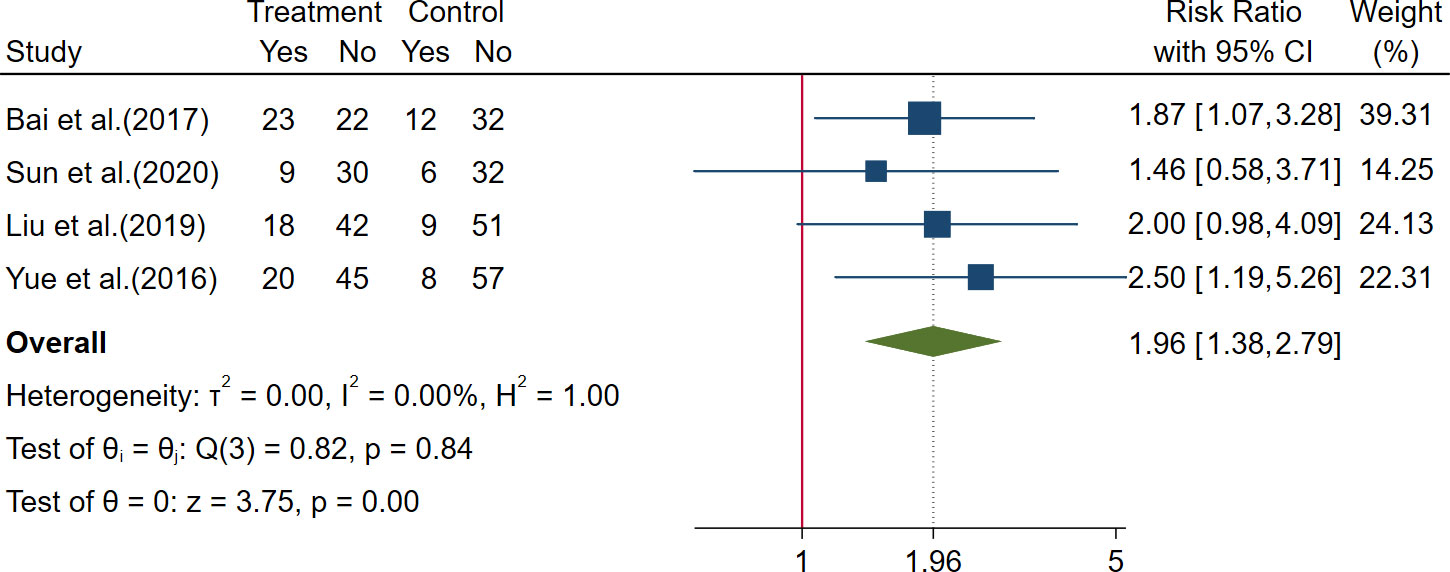
Figure 8 Forest plot of Karnofsky performance status (KPS) improvement rate in postoperative colorectal cancer (CRC).
3.3.2.3 Safety outcomes for postoperative colorectal cancer
Five trials reported the AEs in postoperative patients with CRC, a meta-analysis showed that compared to chemotherapy alone, herbal formulas plus chemotherapy may decrease the incidence of leucopenia and nausea and vomiting, and there were no significant differences in the incidence of neutropenia, anemia, thrombocytopenia, diarrhea, and peripheral neurotoxicity (Bai et al., 2017, Wang and Liu, 2020, Lim, 2014; Dong, 2018; Sun, 2020); the results are shown in Table 3.
3.3.3 Herbal formulas with the function of gut microbiota regulation for advanced colorectal cancer
3.3.3.1 Long-term efficacy outcomes for advanced colorectal cancer
Two trials reported long-term survival outcomes (Yang et al., 2008, Zhang et al., 2021a. One trial showed that the 1-year survival rate and 2-year survival rate in patients who received Quxie Capsule were higher than that in patients who received standard treatment by 55% [RR = 1.55, 95% CI (1.15, 2.08)] and 202% [RR = 3.02, 95% CI (1.25, 7.28)], and no significant difference was observed in 3-year survival rate between two groups (Zhang et al., 2021a). Both two trials reported that herbal drugs Quxie Capsule may prolong the mOS in advanced CRC, but a meta-analysis was not performed owing to the existence of considerable heterogeneity (Yang et al., 2008, Zhang et al., 2021a). The results of survival outcomes are shown in Table 3.
3.3.3.2 Outcomes of tumor response rate for advanced colorectal cancer
Five trials evaluated the TRR of herbal formulas plus chemotherapy, and outcomes of ORR and DCR were reported (Nan and Li, 2016, Zhang et al., 2018, Jia et al., 2021, Jia and Dong, 2019; Wang et al., 2018; Xia et al., 2021). The meta-analysis showed that there were no significant differences in ORR or DCR between patients who received herbal formulas plus chemotherapy and patients who received chemotherapy alone. The results are shown in Figures 9, 10 and Table 3.
3.3.3.3 Other efficacy outcomes for advanced colorectal cancer
Two trials demonstrated that compared to chemotherapy alone, herbal formulas plus chemotherapy may increase the QoL score (Yang et al., 2008; Xia et al., 2021). Four trials reported the outcome of KPS score; three trials showed that compared to chemotherapy alone, herbal formulas plus chemotherapy may increase the KPS score (Yang et al., 2008, Jia and Dong, 2019, Xue et al., 2021); another trial reported no significant difference in KPS score between two groups (Liu, 2016). The meta-analysis for these two outcomes was not conducted owing to the existence of considerable heterogeneity. One trial showed that herbal formulas plus FOLFOX chemotherapy may increase the QLQ-C30 score by 6.93 points as compared to FOLFOX chemotherapy alone (Jia and Dong, 2019). The meta-analysis of three trials showed that herbal formulas plus chemotherapy may help to increase the KPS improvement rate by 62% [RR = 1.62, 95% CI (1.13, 2.32)] (Nan and Li, 2016, Zhang et al., 2018; Wang and Zhang, 2018).
3.3.3.4 Safety outcomes for advanced colorectal cancer
Six trials reported the incidence of AEs in advanced CRC (Wang and Zhang, 2018; Yang et al., 2019, Nan and Li, 2016, Zhang et al., 2018, Jia and Dong, 2019, Xue et al., 2021). The meta-analysis showed that compared to chemotherapy alone, herbal formulas plus chemotherapy could decrease the incidence of myelosuppression by 42% [RR = 0.58, 95% CI (0.42, 0.79)], nausea and vomiting by 33% [RR = 0.67, 95% CI (0.50, 0.91)], diarrhea by 59% [RR = 0.41, 95% CI (0.25, 0.67)], and hepatic and renal dysfunction by 49% [RR = 0.51, 95% CI (0.33, 0.79)]. The results are shown in Figure 11 and Table 3.
3.4 Publication bias
Analysis of publication bias was not implemented since the studies included in separate subgroups were less than 10.
3.5 Quality of evidence assessment
We assessed 21 synthesized pieces of evidence with GRADE. A total of 14 of these outcomes were assessed as low certainty, and seven were very low certainty. The main reasons to downgrade the quality of evidence are the unsatisfactory risk of bias and the limited sample size of included trials. The summary of findings is shown in Table 4.
4 Discussion
In this study, after pre-searching classical Chinese herbal prescriptions and Chinese patent medicines that regulate gut microbiota, we assessed the efficacy and safety of HFGMR in GC and CRC. 1) In perioperative stages, HFGMR could promote the recovery of gastrointestinal function, shorten the time of hospital stays, improve the QoL in the perioperative period of GC and CRC, and not increase the extra incidence of AEs. 2) In the postoperative stage with adjuvant chemotherapy, HFGMR can improve the QoL of patients and reduce the incidence of nausea and vomiting in both GC and CRC. Furthermore, HFGMR could significantly prolong DFS in CRC and reduce the incidence of anorexia, diarrhea, and peripheral neurotoxicity in GC and leucopenia in CRC. However, a significant difference in long-term survival efficacy for GC was not observed. 3) In the advanced stage, because there is a large heterogeneity of the reported studies in long-term survival, we mainly focus on the TRR. The combination of chemotherapy (except 5-FU+CF+paclitaxel regimen) and HFGMR could significantly improve ORR and DCR in GC. However, it is a pity that there was no significant difference between HFGMR plus chemotherapy and chemotherapy in ORR and DCR in CRC, which might be related to the small number of included studies and sample size. HFGMR plus chemotherapy can improve the QoL and reduce the occurrence of gastrointestinal reactions and myelosuppression. It is worth proposing that HFGMR can improve fatigue in GC and liver and kidney function in CRC.
Several herbal formulas showed their function to regulate the gut microbiota (Shao et al., 2021), but the relationship between the function of regulating gut microbiota and anti-tumor efficacy remains unclear. Danggui Buxue decoction and Liujunzi decoction were reported to downregulate Lactobacillus, which was considered a probiotic in the past, may suppress inflammatory T-cell infiltration and promote tumor growth in pancreatic cancer (Shi et al., 2021, Cheng et al., 2021a; Hezaveh et al., 2022). Herbal formulas exerted anti-cancer efficacy through multiple mechanisms and pathways, and regulation of gut microbiota requires more attention. Previous studies showed that herbal formulas can improve the TRR, QoL, peripheral blood immune cell function, and fatigue status (Huang et al., 2020); reduce the incidence of AEs (Chen et al., 2018; Lu et al., 2021); and improve 1- and 2-year survival rates and the occurrence of liver dysfunction, renal dysfunction, neurotoxicity, and alopecia in gastrointestinal cancer patients, which is consistent with our study (Cheng et al., 2021b). Interestingly, a previous study evaluating the efficacy of herbal formulas combined with paclitaxel-based chemotherapy in GC found that the combination therapy could significantly improve the TRR [ORR: 1.39; 95% CI (1.24, 1.57), I2 = 12%], and the small sample size was the disadvantage (Li et al., 2020c). Inconsistent with this study, it was reported that herbal formulas combined with chemotherapy can improve the TRR in CRC patients but have no improvement effect on liver and kidney dysfunction (Lin et al., 2019). The reason for this discrepancy between the two studies may be that the trials in our study have a smaller sample size and selection bias. It was found in another study that 5-fluorouracil-based chemotherapy combined with herbal formulas has more effect in improving the TRR in patients with CRC (Chen et al., 2019). As the only Chinese patent medicine included in this meta-analysis, Quxie Capsule was reported in a study to have a good effect on reducing the 1- and 2-year recurrence and metastasis rate and relieving symptoms in CRC, which provide us more information on the long-term effect of HFGMR (Zhang et al., 2021b). However, their quality is low and needs to be confirmed by more high-quality clinical studies.
Although we strictly conducted this meta-analysis according to the review procedure released by the Cochrane Collaboration, this study has several limitations. First, in spite of the definite effect of HFGMR according to the previous studies, only one study reported the results of gut microbiota after medication intervention among the included clinical studies in the meta-analysis. Furthermore, OS and PFS, the main indicators to evaluate the long-term efficacy of anti-tumor treatment, have not been monitored, which makes the long-term effects of HFGMR in GC and CRC remain unknown. Moreover, high-quality original studies were scarce in this study. The problems in most RCTs included a low utilization rate of blinding and unreported lost follow-up cases. Finally, age, gender, race, culture, and diet, as well as geographical location, are the main factors to influence gut microbiota, which have not been reported and considered in this study.
Due to the limitations associated with the poor quality of pooled studies, it is difficult to draw a definitive conclusion. Nevertheless, our study suggests the positive effect of HFGMR in facilitating the management of duration of hospitalization, ORR, DCR and KPS, and AEs in perioperative, postoperative, and advanced GC patients. HFGMR can also improve the PS in postoperative patients with CRC, which might be a positive strategy against GC and CRC, and provides a new therapeutic option in clinical management. In future clinical trials (randomized, double-blind, and placebo-controlled design), factors impacting gut microbiota should be fully considered in the design and implementation process.
5 Conclusion
This study indicates that herbal formulas, which could regulate the composition and proportion of gut microbiota, have a positive effect in three stages (perioperative, postoperative, and advanced) of GC and CRC. They could promote the recovery of postoperative gastrointestinal function, increase TRR, improve KPS, and reduce the incidence of AEs. Herbal formulas exert anti-cancer efficacy through multiple mechanisms and pathways; among them, the regulation of gut microbiota has not been paid enough attention. To further support the conclusion and better understand the role of gut microbiota in the treatment of GC and CRC, more rigorously designed, large-scale, and multicenter RCTs that focus on herbal formulas and gut microbiota are needed in the future.
Author contributions
HW and XW conceived this study. HW and LC registered the protocol. BX and HW performed the search, screen, inclusion, and quality assessment of the included trials. BX and HW conducted the meta-analysis. BX, HW, XW, and YG drafted the first version of this manuscript. BY and RG provided critical revisions and edited the manuscript. JL revised the manuscript. All authors read and approved the final manuscript for submission.
Funding
This study was supported by the China Academy of Chinese Medical Sciences (CACMS) Innovation Fund (Grant no. CI2021A01802).
Conflict of interest
The authors declare that the research was conducted in the absence of any commercial or financial relationships that could be construed as a potential conflict of interest.
Publisher’s note
All claims expressed in this article are solely those of the authors and do not necessarily represent those of their affiliated organizations, or those of the publisher, the editors and the reviewers. Any product that may be evaluated in this article, or claim that may be made by its manufacturer, is not guaranteed or endorsed by the publisher.
Supplementary material
The Supplementary Material for this article can be found online at: https://www.frontiersin.org/articles/10.3389/fcimb.2022.875225/full#supplementary-material
References
Akamaru, Y., Takahashi, T., Nishida, T., Omori, T., Nishikawa, K., Mikata, S., et al. (2015). Effects of daikenchuto, a Japanese herb, on intestinal motility after total gastrectomy: A prospective randomized trial. J. Gastrointest. Surg. 19 (3), 467–472. doi: 10.1007/s11605-014-2730-y
Amoroso, C., Perillo, F., Strati, F., Fantini, M. C., Caprioli, F., Facciotti, F. (2020). The role of gut microbiota biomodulators on mucosal immunity and intestinal inflammation. Cells 9 (5), 1234. doi: 10.3390/cells9051234
Aras, M., Erdil, T. Y., Dane, F., Gungor, S., Ones, T., Dede, F., et al. (2016). Comparison of WHO, RECIST 1.1, EORTC, and PERCIST criteria in the evaluation of treatment response in malignant solid tumors. Nucl. Med. Commun. 37 (1), 9–15. doi: 10.1097/MNM.0000000000000401
Bai, Y., Dai, E., Gao, Z., Liu, W., Chen, F., Wang, X. (2017). ). clinical observation of shenlin baizhu powder improving post-chemotherapy patients with rectal excision. Chin. Tradit. Pat. Med. 39 (2), 278–282.
Cao, W., Zhu, Y., Tang, G., Sheng, C., Zhang, C., Qi, H.. (2020). Effect of modified xiangsha liujunzi decoction combined with progressive rehabilitation training on gastrointestinal function recovery and quality of life in patients with gastric cancer after operation. J. Liaoning. Univ. Tradit. Chin. Med. 22 (8), 147–150. doi: 10.13194/j.issn.1673-842x.2020.08.035.
Chang, C.-W., Lee, H.-C., Li, L.-H., Chiang Chiau, J.-S., Wang, T.-E., Chuang, W.-H., et al. (2020). Fecal microbiota transplantation prevents intestinal injury, upregulation of toll-like receptors, and 5-Fluorouracil/Oxaliplatin-Induced toxicity in colorectal cancer. Int. J. Mol. Sci. 21 (2), 386. doi: 10.3390/ijms21020386
Chen, N. (2013). Early enteral nutrition in combination with ChaiShaoLiuJunZiTang’s influence on postoperative recovery of colorectal cancer of clinical research (Changsha: Hunan University Of Chinese Medicine).
Cheng, M., Hu, J., Zhao, Y., Jiang, J., Qi, R., Chen, S., et al. (2021b). Efficacy and safety of -containing traditional Chinese medicine combined with platinum-based chemotherapy in advanced gastric cancer: A systematic review and meta-analysis. Front. Oncol. 11. doi: 10.3389/fonc.2021.632168
Cheng, Y., Ling, Z., Li, L. (2020). The intestinal microbiota and colorectal cancer. Front. Immunol. 11. doi: 10.3389/fimmu.2020.615056
Cheng, S., Zhang, X. X., Liang, L., Zhang, J. F., Lu, Y., Li, Z. D. (2021a). Regulatory effect of modified liu junzitang on immune function, nutritional status and intestinal microecology in advanced gastric cancer patients with syndrome of deficiency of qi and blood. Chin. J. Exp. Med. Formul. 27 (5), 98–104. doi: 10.13422/j.cnki.syfjx.20210543
Chen, N., Liu, H., Ni, Z., Wang, Y., Peng, S. (2020). Effects of modified chaishao liujunzi decoction combined with enhanced recovery after surgery on rehabilitation of laparoscopic gastric cancer surgery. J. Tradit. Chin. Med. Univ. Hunan. 40 (5), 626–629.
Chen, P., Ni, W., Xie, T., Sui, X. (2019). Meta-analysis of 5-Fluorouracil-Based chemotherapy combined with traditional Chinese medicines for colorectal cancer treatment. Integr. Cancer Ther. 18, 1534735419828824. doi: 10.1177/1534735419828824
Chen, Y., Zhang, G., Chen, X., Jiang, X., Bie, F., Yuan, N., et al. (2018). Jianpi bushen, a traditional Chinese medicine therapy, combined with chemotherapy for gastric cancer treatment: A meta-analysis of randomized controlled trials. Evidence-Based Complement. Altern. Med. eCAM. 2018, 4924279. doi: 10.1155/2018/4924279
Dong, Y. (2018). Effects of jiawei sijunzi decoction on the life quality of patients with qi deficiency of spleen and stomach after chemotherapy for colorectal cancer. J. Community Med. 16 (11), 49–51.
Egger, M., Smith, G. D., Schneider, M., Minder, C. (1997). Bias in meta-analysis detected by a simple, graphical test. BMJ (7109) 315, 629–34. doi: 10.1136/bmj.315.7109.629
Fan, X., Jin, Y., Chen, G., Ma, X., Zhang, L. (2021). Gut microbiota dysbiosis drives the development of colorectal cancer. Digestion 102 (4), 508–515. doi: 10.1159/000508328
Fu, Y., Feng, Y., Chen, R., Tan, Z., Chen, Z. (2007). Clinical observation on HuangqiSijunzi decoction combined with parenteral nutrition in promoting postoperative recovery of gastric cancer patients. J. Guangzhou. Univ. Tradit. Chin. Med. 24 (6), 459–461 465. doi: 10.13359/j.cnki.gzxbtcm.2007.06.023
Guyatt, G. H., Oxman, A. D., Vist, G. E, et al. (2008). GRADE: An emerging consensus on ratingquality of evidence and strength of recommendations. BMJ 336, 924–26. doi: 10.1136/bmj.39489.470347.AD
Hanada, K., Wada, T., Kawada, K., Hoshino, N., Okamoto, M., Hirata, W., et al. (2021). Effect of herbal medicine daikenchuto on gastrointestinal symptoms following laparoscopic colectomy in patients with colon cancer: A prospective randomized study. BioMed. Pharmacother. 141, 111887. doi: 10.1016/j.biopha.2021.111887
Hezaveh, K., Shinde, R. S., Klötgen, A., Halaby, M. J., Lamorte, S., Ciudad, M. T., et al. (2022). Tryptophan-derived microbial metabolites activate the aryl hydrocarbon receptor in tumor-associated macrophages to suppress anti-tumor immunity. Immunity 55 (2), 324–340.e8. doi: 10.1016/j.immuni.2022.01.006
Higgins, J. P. T., Thomas, J., Chandler, J., Cumpston, M., Li, T., Page, M. J., et al (2019). Cochrane Handbook for Systematic Reviews of Interventions version 6.0 (updated July 2019). Cochrane 2019 Available at: http://www.training.cochrane.org/handbook.
Huang, Y., Cao, Y., Shui, M. (2018). Effect of fast-track surgery combined with xiangsha liujunzi decoction on early postoperative recovery of gastrointestinal function in patients with advanced gastric cancer. Pract. Clin. Med. 19 (9), 36–38 79. doi: 10.13764/j.cnki.lcsy
Huang, Z., Zhang, Q., Fan, Y., Zhou, J., Liang, M., Deng, X., et al. (2020). Effect of traditional Chinese medicine injection on cancer-related fatigue: A meta-analysis based on existing evidence. Evidence-Based Complement. Altern. Med. eCAM. 2020, 2456873. doi: 10.1155/2020/2456873
Jia, R., Dong, X. (2019). Clinical study on modified sijunzi tang in adjuvant treatment for advanced rectal cancer. New Chin. Med. 51 (5), 103–106. doi: 10.13457/j.cnki.jncm.2019.05.030
Jia, L., Zhang, Y. (2017). 59 cases of gastric cancer treated by shenlingbaizhu powder combined with chemotherapy. China’s. Naturopathy. 25 (11), 55–56.
Katsuno, H., Maeda, K., Kaiho, T., Kunieda, K., Funahashi, K., Sakamoto, J., et al. (2015). Clinical efficacy of daikenchuto for gastrointestinal dysfunction following colon surgery: A randomized, double-blind, multicenter, placebo-controlled study (JFMC39-0902). Japanese. J. Clin. Oncol. 45 (7), 650–656. doi: 10.1093/jjco/hyv056
Katsuno, H., Maeda, K., Ohya, M., Yoshioka, K., Tsunoda, A., Koda, K., et al. (2016). Clinical pharmacology of daikenchuto assessed by transit analysis using radiopaque markers in patients with colon cancer undergoing open surgery: A multicenter double-blind randomized placebo-controlled study (JFMC39-0902 additional study). J. Gastroenterol. 51 (3), 222–229. doi: 10.1007/s00535-015-1100-1
Kocarnik, J. M., Compton, K., Dean, F. E., Fu, W., Gaw, B. L., Harvey, J. D., et al. (2021). Cancer incidence, mortality, years of life lost, years lived with disability, and disability-adjusted life years for 29 cancer groups from 2010 to 2019: A systematic analysis for the global burden of disease study 2019. JAMA Oncol 8(3), 420–44. doi: 10.1001/jamaoncol.2021.6987
Lai, Y., Huang, Z., Wang, Y. (2018). Effect of shenlingbaizhu powder on immunosuppression of intensive dose chemotherapy for gastric cancer. Fujian. J. Tradit. Chin. Med. 49 (6), 103–106. doi: 10.13260/j.cnki.jfjtcm.011725
Li, Y. (2017). Effect of large dosage of shenlingbaizhu powder on tolerance of postoperative chemotherapy and quality of life of gastric cancer. Guangming. J. Chin. Med. 32 (21), 3100–3102.
Li, Y. (2020). Effects of sijunzi decoction and enteral nutrition on immune function of patients with gastric cancer after operation. Guid. China Med. 18 (19), 152–153. doi: 10.15912/j.cnki.gocm.2020.19.071
Li, T., Chen, N., Wu, D., Lai, Y., Chen, Y., Yu, J. (2010). Clinical observation of liujunzi decoction combined with chemotherapy for advanced gastric cancer. J. Shandong. Univ. Tradit. Chin. Med. 34 (2), 154–155. doi: 10.16294/j.cnki.1007-659x.2010.02.039
Li, H., Guo, L., Han, B., Li, L., Li, L. (2020a). Regulation of shenling baizhu powder on intestinal Microflora,Intestinal barrier and immune function in gastric cancer patients with chemotherapy after operation. Anti-Tumor. Pharm. 10 (4), 477–482. doi: 10.3969/j.issn.2095-1264.2020.04
Li, Y., Li, Z. X., Xie, C. Y., Fan, J., Lv, J., Xu, X. J., et al. (2020b). Gegen qinlian decoction enhances immunity and protects intestinal barrier function in colorectal cancer patients via gut microbiota. World J. Gastroenterol. 26 (48), 7633–7651. doi: 10.3748/wjg.v26.i48.7633
Lim, Y. (2014). Study on sijunzi decoction treatment of colorectal cancer after chemotherapy side effects (Guangzhou: Guangzhou University of Chinese Medicine).
Lin, S., An, X., Guo, Y., Gu, J., Xie, T., Wu, Q., et al. (2019). Meta-analysis of astragalus-containing traditional Chinese medicine combined with chemotherapy for colorectal cancer: Efficacy and safety to tumor response. Front. Oncol. 9. doi: 10.3389/fonc.2019.00749
Lin, H., Wu, D., Yang, A. (2017). Clinical observation on improving quality of life of patients with advanced gastric cancer treated with chemotherapy with liujunzi decoction. Strait. Pharm. J. 29 (6), 152–153.
Li, Y., Sui, X., Su, Z., Yu, C., Shi, X., Johnson, N. L., et al. (2020c). Meta-analysis of paclitaxel-based chemotherapy combined with traditional Chinese medicines for gastric cancer treatment. Front. Pharmacol. 11. doi: 10.3389/fphar.2020.00132
Liu, Y. (2016). Clinical study on treating advanced colorectal cancer in SHENLINGBAIZHU decoction (Guangzhou: Guangzhou University of Chinese Medicine).
Liu, J., Wang, Y., Zhou, X., Wang, Y., Wang, H., Leng, B. (2019). Therapeutic effect of jiawei sijunzi decoction on postoperative patients with rectal cancer. World Lat. Medi. Inform 19 (20), 40–41. doi: 10.19613/j.cnki.1671-3141.2019.20.017
Liu, S., Xia, C. (2019). Efficacy of the xiangsha liujunzi decoction on quality of life in patients with postoperative chemotherapy for colorectal cancer. Clin. J. Chin. Med. 11 (35), 92–94. doi: 10.1097/CM9.0000000000000027
Li, Z., Xu, L., Xue, T., Liu, S., Lin, X. (2016). Clinical observation on 50 cases of advanced gastric carcinoma treated with shenling baizhu powder combined TS chemotherapy regimen. J. Tradit. Chin. Med. 57 (16), 1393–1396. doi: 10.13288/j.11-2166/r.2016.16.012
Lu, C., Ke, L., Li, J., Wu, S., Feng, L., Wang, Y., et al. (2021). Chinese Medicine as an adjunctive treatment for gastric cancer: Methodological investigation of meta-analyses and evidence map. Front. Pharmacol. 12. doi: 10.3389/fphar.2021.797753
Lv, J., Jia, Y., Li, J., Kuai, W., Li, Y., Guo, F., et al. (2019). Gegen qinlian decoction enhances the effect of PD-1 blockade in colorectal cancer with microsatellite stability by remodelling the gut microbiota and the tumour microenvironment. Cell Death Dis. 10 (6), 415. doi: 10.1038/s41419-019-1638-6
Mármol, I., Sánchez-de-Diego, C., Pradilla Dieste, A., Cerrada, E., Rodriguez Yoldi, M. J. (2017). Colorectal carcinoma: A general overview and future perspectives in colorectal cancer. Int. J. Mol. Sci. 18 (1), 197. doi: 10.3390/ijms18010197
Meng, C., Bai, C., Brown, T. D., Hood, L. E., Tian, Q. (2018). Human gut microbiota and gastrointestinal cancer. Genomics. Proteomics Bioinf. 16 (1), 33–49. doi: 10.1016/j.gpb.2017.06.002
Moher, D., Liberati, A., Tetzlaff, J., Altman, D. G., and, Prisma Group (2009). Preferred Reporting Items for Systematic Reviews and Meta-Analyses: the PRISMA Statement. Plos Med. 6 (7), e1000097. doi: 10.1371/journal.pmed.1000097
Nan, B., Li, X. (2016). EClinical observation of shenling baishu powder addition and subtraction combined with chemotherapy in the treatment of advanced colorectal cancer. China Pharm. 27 (33), 4646–4648. doi: 10.6039/j.issn.1001-0408.2016.33.13
Overacre-Delgoffe, A. E., Bumgarner, H. J., Cillo, A. R., Burr, A. H. P., Tometich, J. T., Bhattacharjee, A., et al. (2021). Microbiota-specific T follicular helper cells drive tertiary lymphoid structures and anti-tumor immunity against colorectal cancer. Immunity 54 (12), 2812–24. doi: 10.1016/j.immuni.2021.11.003
Quan, L.-H., Zhang, C., Dong, M., Jiang, J., Xu, H., Yan, C., et al. (2020). Myristoleic acid produced by enterococci reduces obesity through brown adipose tissue activation. Gut 69 (7), 1239–1247. doi: 10.1136/gutjnl-2019-319114
Shao, S., Jia, R., Zhao, L., Zhang, Y., Guan, Y., Wen, H., et al. (2021). Xiao-Chai-Hu-Tang ameliorates tumor growth in cancer comorbid depressive symptoms via modulating gut microbiota-mediated TLR4/MyD88/NF-κB signaling pathway. Phytomedicine 88, 153606. doi: 10.1016/j.phymed.2021.153606
Shen, Q., Zhou, D., Liu, J. (2021). Effect of liujunzi decoction on median disease progression short-term survival of advanced gastric gancer. Forum Tradit. Chin. Med. 36 (6), 44–46. doi: 10.13913/j.cnki.41-1110/r.2021.06.017
Shi, X. Q., Zhu, Z. H., Yue, S. J., Tang, Y. P., Chen, Y. Y., Pu, Z. J., et al. (2021). Studies on blood enrichment and anti-tumor effects of combined danggui buxue decoction, fe and rhEPO based on colon cancer-related anemia model and gut microbiota modulation. Chin. J. Nat. Med. 19 (6), 422–431. doi: 10.1016/S1875-5364(21)60041-9
Sterne, J. A. C., Savović, J., Page, M. J., Elbers, R. G., Blencowe, N. S., Boutron, I., et al. (2019). RoB 2: a Revised Tool for Assessing Risk of Bias in Randomised Trials. BMJ 366 (2019), l4898. doi: 10.1136/bmj.l4898
Sun, D. (2020). Study on the improvement of immune function of patients with colon cancer of damp heat accumulation type by modified gegen qinlian decoction combined with chemotherapy (Jinan: Shandong University of Traditional Chinese Medicine).
Sun, X. N., Guo, Y., Zhu, M. L. (2012). Effects of probiotics on immune function in postoperative colorectal cancer patients receiving adjuvant chemotherapy. J. Pract. Oncol. 27 (6), 610–612. doi: 10.13267/j.cnki.syzlzz.2012.06.022
Sun, L., Yan, Y., Chen, D., Yang, Y. (2020). Quxie capsule modulating gut microbiome and its association with T cell regulation in patients with metastatic colorectal cancer: Result from a randomized controlled clinical trial. Integr. Cancer Ther. 219, 1534735420969820. doi: 10.1177/1534735420969820
Tong, X., Xu, C., Li, M., Yu, X. W., Fang, M. H., Tao, Z. H. (2017). The influence of modified xiangsha liujunzi decoction for patients of postoperative colorectal cancer on quality of life. J. Yunnan. Univ. Tradit. Chin. Med. 40 (1), 37–40. doi: 10.19288/j.cnki.issn.1000-2723.2017.01.009
Wakasugi, M., Suzuki, Y., Tei, M., Ueshima, S., Akamatsu, H., Nishida, T. (2020). Effects of daikenchuto on postoperative gastrointestinal motility in colorectal carcinoma patients with abdominal pain and distension: A prospective, randomized trial. Surg. Today 50 (11), 1524–1529. doi: 10.1007/s00595-020-02052-0
Wang, F., Du, X. Y., Chen, S. Q. (2019). Clinical effect of modified sijunzi decoction combined with apatinib in treatment of advanced gastric cancer with deficiency of spleen qi and stomach qi in elderly patients: An analysis of 30 cases. Hunan. J. Tradit. Chin. Med. 35 (8), 10–13. doi: 10.16808/j.cnki.issn1003-7705.2019.08.004
Wang, Y., Jiang, B., Fang, M. Z., Wang, S. M., Xiao, Y., Ma, M., et al. (2018). A study of the intervention effect of ’Jia Wei Dang Gui Bu Xue Tang’ to the immune function and bone barrow suppression of the patients with postoperative chemotherapy for colorectal cancer. Jiangsu. J. Tradit. Chin. Med. 50 (12), 33–35. doi: 10.3969/j.issn.1672-397X.2018.12.013
Wang, H. Y., Liu, G. R. (2020). Effect of shenling baizhu powder combined with chemotherapy on immune function and quality of life of colorectal cancer. Chin. Mod. Med. 27 (9), 78–80, 84.
Wang, H. ,. T., Yan, L. Z. (2020). Effect of liujunzi decoction on KPS score and survival of advanced gastric cancer with deficiency of spleen qi. J. Home. Med. 11), 152–153.
Wang, M. R., Zhang, P. T. (2018). Analysis of the therapeutic effect of Chinese and western combination therapy for colon cancer. J. Basic. Chin. Med. 24 (10), 1438–1440.
Wang, X. H., Zhou, Q., Liu, X. M. (2014). Clinical observation of shenlinbaizhu powder combined with western medicine for gastric cancer. Pract. J. Cancer 29 (11), 1464–1466. doi: 10.3969/j.jssn.1001-5930.2014.11.035
Weng, M.-T., Chiu, Y.-T., Wei, P.-Y., Chiang, C.-W., Fang, H.-L., Wei, S.-C. (2019). Microbiota and gastrointestinal cancer. J. Formosan. Med. Assoc. = Taiwan. yi. zhi. 118 Suppl 1, S32–S41. doi: 10.1016/j.jfma.2019.01.002
Xia, X. T., Zhao, Z. B., Li, Y., Chen, Z. Y., Yu, Y. S., Zhong, Y. (2021). Effect of modified sijunzi tang on immune function and quality of life in patients with advanced rectal cancer. J. New Chin. Med. 53 (3), 107–110. doi: 10.13457/j.cnki.jncm.2021.03.027
Xie, Y. H., Chen, J. (2020). Effects of zhipo liujunzi decoction combined with sequential treatment on T lymphocyte subsets in patients with middle or advanced stage gastric cancer. J. Clin. Med. Pract. 24 (8), 47–50. doi: 10.7619/jcmp.202008012
Xue, M. J., Sun, Y., Huang, M. (2021). Adverse reactions of chemotherapy in patients with colon cancer treated with sijunzi decoction and the effect on changes of serum PLT, AST and ALT levels. J. Mod. Oncol. 29 (7), 1161–1165. doi: 10.3969/j.issn.1672-4992.2021.07.013
Xu, X., Gao, Z., Yang, F., Yang, Y., Chen, L., Han, L., et al. (2020). Antidiabetic effects of gegen qinlian decoction via the gut microbiota are attributable to its key ingredient berberine. Genomics. Proteomics Bioinf. 18 (6), 721–736. doi: 10.1016/j.gpb.2019.09.007
Yaegashi, M., Otsuka, K., Itabashi, T., Kimura, T., Kato, K., Fujii, H., et al. (2014). Daikenchuto stimulates colonic motility after laparoscopic-assisted colectomy. Hepatogastroenterology 61 (129), 85–89.
Yang, S. Z. (2015). Clinical study on reducing recurrence and metastasis of colon cancer in II III period with quxie capsule. Clin. J. Chin. Med. 7 (5), 8–10. doi: 10.3969/j.issn.1674-7860.2015.5.004
Yang, W. (2021). Influence of modified sijunzi decoction on gastrointestinal function and levels of VEGF, aFGF and bFGF in patients with rectal cancer. Guangming. J. Chin. Med. 36 (11), 1751–1753. doi: 10.3969/j.issn.1003-8914.2021.11.007
Yang, Y. F., Chen, Z. X., Xu, Y., Wu, Y., Wu, X. W., Zhu, Y. W., et al. (2008). Randomized controlled study on effect of quxie capsule on the median survival time and quality of life in patients with advanced colorectal carcinoma. Chin. J. Integr. Tradit. West. Med. 28 (2), 111–114. doi: 10.3321/j.issn:1003-5370.2008.02.004
Yang, X., Guo, Y., Chen, C., Shao, B., Zhao, L., Zhou, Q., et al. (2021). Interaction between intestinal microbiota and tumour immunity in the tumour microenvironment. Immunology 164 (3), 476–493. doi: 10.1111/imm.13397
Yang, D. Z., Hui, Y., Wu, Y. C., Jiang, J., Jia, Y., Tian, B., et al. (2019). Danggui buxue decoction combined with capecitabine metronomic chemotherapy in the treatment of advanced colorectal cancer. Jilin. J. Chin. Med. 39 (8), 1032–1036. doi: 10.13463/j.cnki.jlzyy.2019.08.015
Yang, Y. F., Xu, Y., Wu, Y., Wang, L. P., Li, Z., Zhang, L. Z., et al. (2007). Clinical randomized double-blinded controlled study on quxie capsule in reducing post-operational relapse and metastasis of colorectal cancer. Chin. J. Integr. Tradit. West. Med. 27 (10), 879–882. doi: 10.3321/j.issn:1003-5370.2007.10.006
Yoshikawa, K., Shimada, M., Wakabayashi, G., Ishida, K., Kaiho, T., Kitagawa, Y., et al. (2015). Effect of daikenchuto, a traditional Japanese herbal medicine, after total gastrectomy for gastric cancer: A multicenter, randomized, double-blind, placebo-controlled, phase II trial. J. Am. Coll. Surg. 221 (2), 571–578. doi: 10.1016/j.jamcollsurg.2015.03.004
Yue, S. (2016). Effects of sijunzi decoction on immunologic function and quality of life in patients with rectal carcinoma after surgery. J. Nanjing. Univ. Tradit. Chin. Med. 32 (4), 334–336. doi: 10.14148/j.issn.1672-0482.2016.0334
Yue, H. G., Li, L. X., Yuan, D. D. (2019). The effect of liujunzi decoction on gastric cancer patients with postoperative recovery time and its regulation of serum miR-25. J. Med. Theor. Prac. 32 (13), 1981–1983. doi: 10.19381/j.issn.1001-7585.2019.13.005
Yu, X. K., Ren, P. (2019). Effect of sijunzi decoction combined with enteral nutrition on immune function and serum TP and TRF levels in postoperative patients with gastric cancer. Acta Chin. Med. 34 (3), 621–624. doi: 10.16368/j.issn.1674-8999.2019.03.146
Zhang, S. (2020). Clinical study on jiawei liujunzi decoction to promote gastrointestinal function recovery after colorectal cancer radical operation (Taiyuan: Shanxi Provincial Institute of TCM).
Zhang, S., Lian, P., Huang, T., Zhou, J. (2021b). Effect of quxie capsule in patients with colorectal cancer: A systematic review and meta-analysis. Medicine 100 (7), e24322. doi: 10.1097/MD.0000000000024322
Zhang, H., Su, Z. X. (2008). Curative effect of shenling baizhu powder on chemotherapy- induced toxicity in advanced gastric cancer. J. Hunan. Univ. Chin. Med. 28 (2), 51–53, 56.
Zhang, F. R., Xie, A. S., Zhang, J. H., Cai, X. M., Chen, J. T., Li, W. (2020). Clinical study on the influence of sijunzi decoction on gut microbiota and immune function of postoperative patients with colorectal cancer chemotherapy. J. Shantou. Univ. Med. Coll. 33 (4), 206–208. doi: 10.13401/j.cnki.jsumc.2020.04.004
Zhang, T., Xu, Y., Sun, L. Y., He, B., Hao, J., Zhang, D., et al. (2021a). Efficacy of quxie capsule in metastatic colorectal cancer: long-term survival update of a double-blind, randomized, placebo controlled trial. Chin. J. Integr. Med, 1–4. doi: 10.1007/s11655-021-3281-1
Zhang, J. ,. Y., Zhang, Y., Wang, X. L. (2018). Guishao liujun decoction combined with raltitrexed chemotherapy in the treatment of 31 cases of advanced colorectal cancer. Zhejiang. J. Tradit. Chin. Med. 53 (6), 446–447. doi: 10.13633/j.cnki.zjtcm.2018.06.040
Zhong, Z. J., Hu, C., Liu, J. Y. (2019). Efficacy of shenling baizhu San plus FOLFOX4 on advanced gastric cancer. Clin. J. Chin. Med. 11 (31), 84–86. doi: 10.3969/j.issn.1674-7860.2019.31.029
Keywords: herbal formulas, gut microbiota, gastric cancer, colorectal cancer, meta-analysis, efficacy, safety
Citation: Xu B, Wang X, Wang H, Cao L, Ge Y, Yuan B, Gao R and Li J (2022) Efficacy and safety of herbal formulas with the function of gut microbiota regulation for gastric and colorectal cancer: A systematic review and meta-analysis. Front. Cell. Infect. Microbiol. 12:875225. doi: 10.3389/fcimb.2022.875225
Received: 14 February 2022; Accepted: 04 July 2022;
Published: 04 August 2022.
Edited by:
Antonio Biondi, University of Catania, ItalyReviewed by:
Carolina De Almeida, University of Florence, ItalyAntonio Biondi, University of Catania, Italy
Copyright © 2022 Xu, Wang, Wang, Cao, Ge, Yuan, Gao and Li. This is an open-access article distributed under the terms of the Creative Commons Attribution License (CC BY). The use, distribution or reproduction in other forums is permitted, provided the original author(s) and the copyright owner(s) are credited and that the original publication in this journal is cited, in accordance with accepted academic practice. No use, distribution or reproduction is permitted which does not comply with these terms.
*Correspondence: Jie Li, qfm2020jieli@yeah.net
†These authors have contributed equally to this work
 Bowen Xu
Bowen Xu Xinmiao Wang
Xinmiao Wang Heping Wang
Heping Wang Luchang Cao
Luchang Cao Yuansha Ge
Yuansha Ge Bo Yuan
Bo Yuan Ruike Gao1
Ruike Gao1  Jie Li
Jie Li